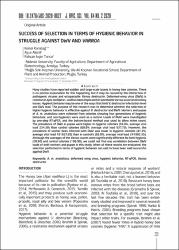| dc.contributor.author | Karabağ, Kemal | |
| dc.contributor.author | Alemli, Ayşe | |
| dc.contributor.author | İvgin Tunca, Rahşan | |
| dc.date.accessioned | 2021-02-11T11:12:40Z | |
| dc.date.available | 2021-02-11T11:12:40Z | |
| dc.date.issued | 2020 | en_US |
| dc.identifier.citation | Karabaǧ, K., Alemli, A., & Tunca, R. I. (2021). Success of selection in terms of hygienic behavior in struggle against DWV and varroa. Journal of Apicultural Science, 64(2), 229-240. doi:10.2478/jas-2020-0027 | en_US |
| dc.identifier.issn | 1643-4439 | |
| dc.identifier.issn | 2299-4831 | |
| dc.identifier.uri | https://doi.org/10.2478/jas-2020-0027 | |
| dc.identifier.uri | https://hdl.handle.net/20.500.12809/8948 | |
| dc.description.abstract | Many studies have reported sudden and large-scale losses in honey bee colonies. There is no precise explanation for this happening, but it may be caused by the interaction of pathogenic viruses and ectoparasite Varroa destructor. Deformed-wing virus (DWV) is common in Apis mellifera L. and has been implicated in worldwide Varroa-associated colony losses. Hygienic behavior may be one of the ways that limit V. destructor infestation level and DWV load. The purpose of this research was to determine whether the selection of higher hygienic behavior is effective against V. destructor and DWV. Workers and pupae
of A. m. anatoliaca were collected from colonies showing four generations of hygienic behaviodr, and non-hygienics were used as a control. Loads of DWV were investigated by one-step RT-qPCR, and the bottom-board method was used to allow mites count. The prevalence of DWV in pupae were higher in hygienic colonies (69.0%, average viral load 234.38) than control colonies (60.8% average viral load 937.70). However, the prevalence of worker bees infected with DWV was lower in hygienic colonies (41.3%, average viral load 181627.69) than in control’s (66.0%, average viral load 241982.35). Although the averages of the Varroa counts were significantly different for both hygienic (28.92) and control colonies (108.90), we could not find any correlation between DWV loads of both workers and pupae in this study. When all these results are evaluated, the selection performed in terms of hygienic behavior can said to have been said successful against DWV. | en_US |
| dc.description.sponsorship | Akdeniz University Scientific Research Projects Coordination Unit ; Mugla Beekeeping Association (MAYBIR) | en_US |
| dc.item-language.iso | eng | en_US |
| dc.publisher | RESEARCH INST POMOLOGY FLORICULTURE | en_US |
| dc.relation.isversionof | 10.2478/JAS-2020-0027 | en_US |
| dc.item-rights | info:eu-repo/semantics/openAccess | en_US |
| dc.subject | A. m. anatoliaca | en_US |
| dc.subject | Deformed wing virus | en_US |
| dc.subject | Hygienic behavior | en_US |
| dc.subject | RT-qPCR | en_US |
| dc.subject | Varroa destructor | en_US |
| dc.title | SUCCESS OF SELECTION IN TERMS OF HYGIENIC BEHAVIOR IN STRUGGLE AGAINST DWV AND VARROA | en_US |
| dc.item-type | article | en_US |
| dc.contributor.department | MÜ, Ula Ali Koçman Meslek Yüksekokulu, Bitkisel Ve Hayvansal Üretim Bölümü | en_US |
| dc.contributor.authorID | 0000-0003-0745-6732 | en_US |
| dc.contributor.institutionauthor | İvgin Tunca, Rahşan | |
| dc.identifier.volume | 64 | en_US |
| dc.identifier.issue | 2 | en_US |
| dc.identifier.startpage | 229 | en_US |
| dc.identifier.endpage | 240 | en_US |
| dc.relation.journal | JOURNAL OF APICULTURAL SCIENCE | en_US |
| dc.relation.publicationcategory | Makale - Uluslararası Hakemli Dergi - Kurum Öğretim Elemanı | en_US |


















